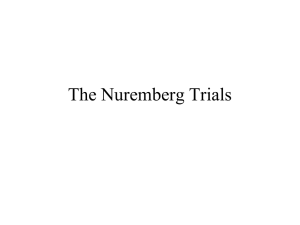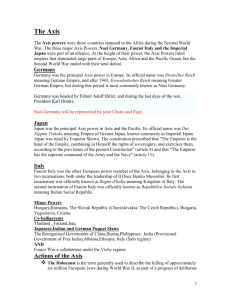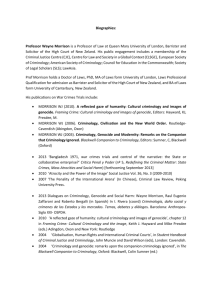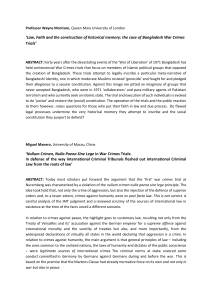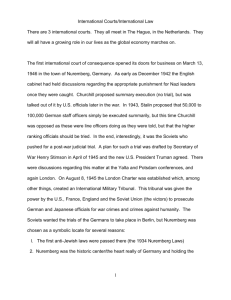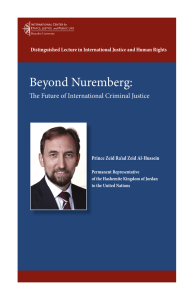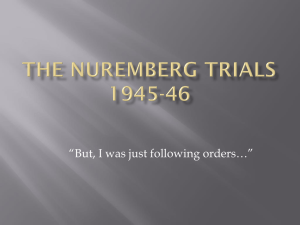Memories of the Holocaust * and the Law
advertisement
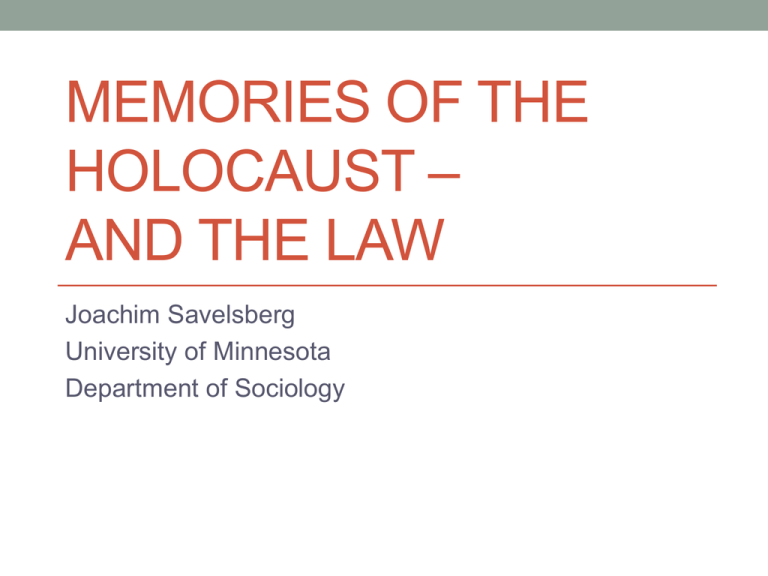
MEMORIES OF THE HOLOCAUST – AND THE LAW Joachim Savelsberg University of Minnesota Department of Sociology Sources assigned and referred to in presentation • Stiftung Topographie des Terrors. 2010. Topography of Terror. Berlin (catalogue). • Devin O. Pendas. 2006 The Frankfurt Auschwitz Trial, 1963-1965: Genocide, • • • • • • • History and the Limits of the Law. Cambridge: Cambridge University Press. Tomaz Jardim. 2012. The Mauthausen Trial: American Military Justice in Germany. Cambridge: Harvard University Press. Joachim Savelsberg and Ryan King. 2011. American Memories: Atrocities and the Law. New York: Russell Sage Foundation (incl. chapter on My Lai in law and history textbooks). Joachim Savelsberg. 2010. Crime and Human Rights: Criminology of Genocide and Atrocities. London: Sage. Patricia Heberer and Juergen Matthaeus (eds.). 2008. Atrocities on Trial: Historical Perspectives on the Politics of Prosecuting War Crimes. Lincoln: University of Nebraska Press. Jeffrey Alexander et al. 2004. Cultural Trauma and Collective Identity. Berkeley: University of California Press. Judgment in Nuremberg (movie -- 1961) Verdict on Auschwitz: The Frankfurt Auschwitz Trial 1963-1965 (documentary film -- 1993) Overview 1. Central terms and ideas • Collective Memory • Cultural Trauma 2. Collective memory – what’s law got to do with it? • Mnemonic potential of law • Institutional logic (limits) of law 3. Legal responses to the Holocaust • Overview • The Nuremberg tribunals (catalogue & “Judgment at Nuremberg”) • The Frankfurt Auschwitz trial (Pendas & “Judgment on Auschwitz”) 4. Beyond the Holocaust: ICC and debates 1. Collective memory • Collective memory (Maurice Halbwachs): • Definition: • knowledge about the past that is shared, mutually acknowledged and reinforced by a collectivity • Mechanisms: • through rituals and symbols (Emile Durkheim), • biography and historiography (Karl Mannheim) • [examples today?] • Features: • constructed, • presentist (Halbwachs, Fine, bridging/mobilization); • path dependent (Olick/Levy), • group specific (generations/cohorts; “Opa was no Nazi” -but great grandpa may have been), • result of mnemonic struggles (Historikerstreit), • in flux (Schwartz/Schuman) Cultural Trauma • Source: Jeffrey Alexander et al. • Definition (Neil Smelser): “a memory accepted and publicly given credence by a relevant membership group and evoking an event or situation that is laden with negative affect, represented as indelible, and regarded as threatening a society’s existence or violating one or more of its cultural presuppositions.” • Application: Holocaust (broad public, perpetrator people), Communist rule, Slavery, 9/11 • Conditions (Alexander): Agents, making claims, representing carrier groups, through speech acts, using cultural classifications of suffering, victimhood and responsibility to reach a wider audience 2. Collective memory and law … hopes • Nuremberg hope • “Roosevelt felt that he had to contend with [WW I revisionists and protagonists of isolationism] as he guided the United States in the war against Hitler and strove to establish the country’s leadership of the entire noncommunist world. Judge Samuel Rosenman, Roosevelt’s confidante… said of his leader: ‘He was determined that the question of Hitler’s guilt—and the guilt of his gangsters— must not be left open to future debate. The whole nauseating matter should be spread out on a permanent record under oath by witnesses and with all the written documents.’” • Robert Jackson: “We must establish incredible events by credible evidence.” • Alternatives: summary executions or show trials • Parallel to common justifications of criminal law • Later hopes: Debates on transitional justice Skepticism: institutional logics • e.g., effects of criminal law interactive with above conditions (conditions of CT à la Alexander applied to law) • Claims making agents, • representing carrier groups • through speech acts, • using cultural classifications of suffering, victimhood and responsibility • e.g., different frames of law than: • Sociology (social structures, cultures) • History (not same evidentiary restrictions) • Psychology (not same binary [guilty- not guilty] classification – also: Primo Levi’s “shades of grey”) • Art, literature, politics, religion, … [focus, criteria?] • example: My Lai study 3. Legal responses to the Holocaust • Trials versus other responses • Trials (4 types) • International trials • International Military Tribunal at Nuremberg (1945-6) • Occupation force trials • Subsequent Nuremberg Trials (1946ff) • Dachau [Mauthausen] trials (Jardim) • Foreign trials • Eichmann trial in Jerusalem (1961) (“banality” – Milgram experiments) • Domestic trials • Police battalion trial (1958) • Frankfurt Auschwitz trial (1963-65) • [Still today: Demjanjuk; Karcok (Minneapolis)] • [Where today/in recent past?] IMT Nuremberg: 21 Nazi defendants • August 1945: London Agreement on IMT • 11/22/1945: Opening of trial (defendants informally representing Nazi organizations) [also: Tokyo trial]; not: Hitler, Goebbels, Himmler (suicides) • Charges 1. Crimes against peace: “planning, preparation, initiation, and waging of a war of aggression, which were also wars in violation of international treatises, agreements, and assurances” 2. Crimes of war: Violations of the laws or customs of war which include, but are not limited to, murder, ill-treatment or deportation of slave labor or for any other purpose of the civilian population of or in occupied territory; murder or ill-treatment of prisoners of war or persons on the Seas, killing of hostages, plunder of public or private property, wanton destruction of cities, towns, or villages, or devastation not justified by military necessity. 3. Crimes against humanity: host of activities (murder, enslavement, deportation) committed against civilian populations “before and during the war… Whether or not in violation of the domestic law of the country where perpetrated” • Particularities • No tu quoque defense (against international standards) • Admission of hearsay evidence • Application of US procedure (adversarial process) • Decisions/outcome: • 12 executions • 7 prison terms • 3 acquittals Reporting the Outcome Subsequent Nuremberg trials • Control Council Law No. 10 • Passed by Allied Control Council • Authorizing allies to prosecute within their respective zones • Crimes against peace, war crimes, crimes against humanity, membership in organizations declared criminal by the IMT • Subsequent Nuremberg Trials: 185 persons indicted in 12 proceedings (physicians, industrialists, SS, military leaders, cabinet/ government officials, …) • Movie: Judgment at Nuremberg [Questions: Potency of legal trials versus their limits?] • Outcome of trials • 147 convictions (25 death; 20 life sentences) • German public opinion: skeptical to negative • US public opinion: positive to skeptical (sharpening Cold War, anti-Communism, antiSemitism, pro-Germanism, German critiques of ‘victors’ justice,” isolationism) • Clemencies after 1951 • Weight of political rationales over judicial ones Michael Marrus on missed opportunities of the “doctors’ trial” • Grave critique: Missed opportunity to • define the principle crimes of German physicians (excessive cruelty, but not 400,000 sterilizations) • identify major perpetrators (some camp perpetrators, but not wider profession) • see them in wider context (ideology of public versus private interest) • sketch an explanation. • Sharp contrast with hopes a la Roosevelt and Jackson: “write the history with clarity” • Reasons for discrepancy • Push to punish important Nazi criminals, to stigmatize the regime (thus attempts to link defendants to Nazi leaders and SS) (political) • Focus on the war period alone (legal) • A criminal conspiracy (a la group of gangsters) rather than as individuals with a shared ideology • Small staff lacking medical expertise (practical) • Establishment of euthanasia culture worldwide (political) Frankfurt -- background • Fritz Bauer (Hesse’s Attorney General) – desire for visible trial • 5/30/1956 – aversion to ex post facto law of London Charter and Control Council Law #10 abolishment and replacement by common German criminal code (despite acknowledgment of international law, no “crimes against humanity”, no “genocide” ex post) • Particular of German criminal code: focus on subjectivities (intent) of perpetrator, ill suited for massive, bureaucratically organized mass killings • 10/31958: Central Office of the State Justice Ministries for the Investigation of National Socialist Crimes of Violence, Ludwigsburg Film segments: The Frankfurt Auschwitz trial and the Pendas account • Historiographical potential? • Symbolic and ritual potential? • Constraints • Legal • contextual 4. Beyond Holocaust trials • Universal Declaration of Human Rights • Convention for the Prevention and Punishment of Genocide • 1915 murder of one million Armenians in Turkey • Hesitant, weak international reaction (during & post WWI) • Soghomon Thelirian murdering Mehmed Tallat (Berlin 1921) • Raphael Lemkin’s question to his law professor—and the • • • • answer about the “owner of a flock of chickens” 1933: Lemkin’s proposal at an international law conference 1940/41 escape via Sweden to US War time failure to convince US authorities of genocide 1946-48 toward Genocide Convention http://www.preventgenocide.org/law/convention/text.htm From Cold War Silence to the ICC • Cold War silence • But domestic: Latin America (Argentina), Greece, Portugal • After 1989 • ICTY • ICTR • Cambodia • Sierra Leone • Iraq • Rome Statute (1998) and ICC (2002): Sudan/Darfur, DRC, … • Debates: Hopes/potentials/limits of domestic, foreign, and international criminal law (memory as mediating force?)


